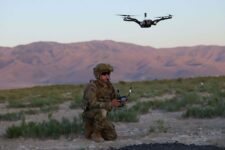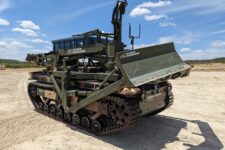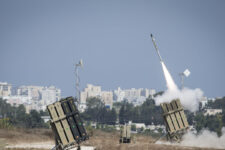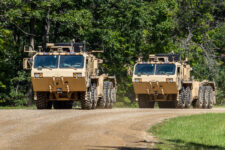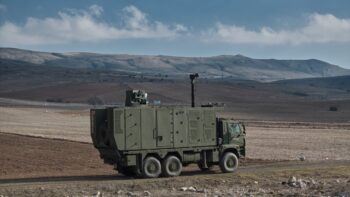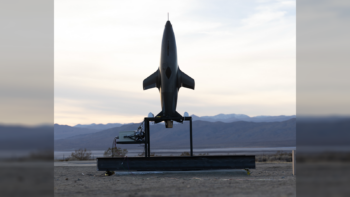
Photo: DroneGun Mk4 courtesy of DroneShield.
The proliferation of mass-produced drones across the battlefields of Ukraine is evidence of the significant impact these platforms have in today’s asymmetric warfare operations. Intelligence collection, surveillance, reconnaissance and direct payload attacks paired with ever-advancing tactics are just a few ways drones are forever changing the future of warfare.
While the war in Ukraine garners a vast amount of attention with its highly publicized use of Unmanned Aerial Systems (UAS), it’s critical that our strategy to counter these threats also accounts for the growing and expanded use of Unmanned Surface Vessel (USV) and Unmanned Ground Vehicle (UGV) platforms too. This evolving threat is not limited solely to the EUCOM theater either. Other areas of operation across AFRICOM, CENTOM, INDOPACOM, and SOUTHCOM are also seeing drastic increases in threats leveraging unmanned systems.
The Army’s Joint Counter-small Unmanned Aircraft Systems Office (or JCO) along with several key Program Offices recognize this reality. Last Fall, JCO director, Maj. Gen. Sean A. Gainey, repeated his call for every service member to become a drone-fighter.
That can only happen by delivering easy to use and cost-effective counter-unmanned systems technology at scale. DroneShield is committed to helping the DoD do just that.
Established in Virginia in 2014, DroneShield, through a decade of continual innovation, has grown into a $590 million company and shows no sign of slowing.
Its systems are sold in dozens of countries around the world, but the United States is by far its largest market with approximately $49 million in DoD and government contracts awarded since 2023. The firm is on a path to accelerated growth with a contract backlog of $27 million and a pipeline of over $700 million.
DroneShield’s success hinges on a commitment to forward leaning technology, developing systems that provide warfighters with the ability to counter not only current, but future unmanned systems threats.
Efficacy, ease of use and cost-effectiveness are all key attributes of its product portfolio. DroneShield’s highly portable systems provide effective, real-time situational awareness and increased survivability at the brigade level and below.
Counter-UxS technology has quickly become a critical requirement in today’s battlespace, however, in most cases operators are still required to direct attention across a wide range of other responsibilities during an operation. For this reason, its paramount that any C-UxS technology adopted ultimately enhances an operator’s overall ability without adding unnecessary complexity. This easy to deploy and readily available C-UxS capability is exactly what DroneShield offers.
DroneShield on Vimeo.
Enabling Decisive Action
The overall speed, maneuverability, reduced size and extremely low noise signature of drones, especially First Person View or FPV drones, make detection extremely difficult. Popping up as specks on the horizon, which could be a couple kilometers to several hundred meters away, the sheer closing speed of these systems leaves little time for identification let alone protective measures. Early warning and effective countermeasures are critical to soldier survivability.
The majority of small UAS rely on some form of radio frequency (RF) link for command and control, satellite guidance, or communication with a remote pilot. Drones send location, video and other telemetry back to their controllers emitting their own electronic signal fingerprint.
These unique signal attributes can be detected and classified by sophisticated RF detection that can distinguish them from other devices (Wi-Fi routers, Bluetooth communications) which often use the same frequencies.
Effective RF detection systems must also account for an ever-increasing variety of new signals, frequencies, signatures and platforms on the battlefield, as evidenced in Ukraine.
DroneShield has approached this problem head on by developing a software-defined detection capability. This approach leverages an advanced artificial intelligence engine which continually scans and processes signal data against a trained algorithm. This AI-based approach provides real-time situational awareness of drone activity, while allowing the end user to maintain focus on operational objectives.
Increased speed of detection and a much higher degree of fidelity are benefits of DroneShield’s AI based detection approach. High performance C-UAS technology becomes even more important in heavily congested RF environments, which is a common area where less sophisticated systems can often struggle, resulting in false detections or potentially catastrophic delayed alerts.

Photo: DroneGun Mk4 and RfPatrol Mk2 courtesy of DroneShield.
One of the systems utilizing the company’s advanced detection capability is its signature handheld device – the RfPatrol Mk2.
Weighing just 2.6 pounds, the RfPatrol is a lightweight, completely passive/non-emitting C-UAS detection system. It provides real-time drone signal detection, identification, and classification, notifying users via visual, haptic, or audible alerts.
The system utilizes standard batteries and has alternate power options for both mobile and stationary use. Simple controls and interoperability with ATAK and MANET radio systems allow operators to share real-time alerts with friendly forces for broader situational awareness. A full suite of multi-mission tools and options such as spectrum viewer, signal recording, and advanced filtering further enhances capability in the field.
A cadence of quarterly threat database updates ensures that the RfPatrol’s software-defined RF detection incorporates the latest in new drone signatures. It’s part of DroneShield’s commitment to help users keep pace with an ever-changing drone landscape.
The partner product to the RfPatrol is the DroneGun Mk4. A ruggedized handheld countermeasure providing a highly directional mitigation capability for force protection against inbound drones.
DroneGun Mk4 shares common design aspects to a soldier’s primary weapons system. The common grip, trigger assembly and safety selector allow muscle memory established with other weapons experience and firearms training to carry over. An intuitive interface allows users to quickly select the appropriate disruption mode to jam the command and control, video, and or GNSS links – at significant ranges. The simple point and shoot design eliminates the need for specialized training or a dedicated MOS to operate. This design affords soldiers with varying levels of technical expertise to be quickly outfitted and fully operational.
The DroneGun Mk4’s jamming typically forces a drone to a vertical controlled landing on the spot or to return to its operator-controller or starting point. Disruption of live video streaming (or FPV) to a remote controller halts the collection of footage and intelligence by the drone operator.
The DroneGun Mk4 is a cost-effective countermeasure providing users with an increased independence and self-sufficiency on the edge and at the individual soldier level. With its electronic countermeasure approach and battery powered aspects DroneGun Mk4 serves as a highly favorable cost-per-shot defeat solution.
With RfPatrol and DroneGun Mk4, DroneShield brings RF detection and defeat – the most effective standalone C-UAS capability – to forces at every level and echelon. The form factor, functionality and unit cost offer the opportunity to properly equip units across a large force with the ability to find and effectively neutralize drones or swarms of drones.
Tom Branstetter, Director of Business Development at DroneShield commented, “The counter-UxS space requires continual development. Our solutions are effective, intuitive and most importantly, built for the Warfighter.”
These easily adopted technologies can help translate the DoD’s vision of every service member a drone-fighter into reality.

Photo: Courtesy of DroneShield
A Wider Ecosystem of Interoperability and Drone Defense
DroneShield has its two offices and production facilities strategically located in Sydney, Australia and Northern Virginia, placing it in a key position for global collaboration.
Its position across two of the Five Eyes member nations and a potential case study for the trilateral AUKUS security partnership streamlines DroneShield’s ability to work closely with U.S. DoD and allied western militaries, government agencies and civil institutions.
The company’s impact is also seen in Europe with its approval in April, 2024 from the NATO Support and Procurement Agency (NSPA) for the first CUAS procurement framework agreement in the NATO Alliance’s history. NSPA essentially evaluates emerging technologies and certifies them as effective and beneficial for use with NATO militaries.
As NATO celebrated its 75th anniversary and reaffirmed its collective commitment in Washington DC this summer, DroneShield’s global counter-drone ecosystem and leading U.S. market position reflect the priorities and urgency that member states are articulating – much needed collaboration around innovation to combat emerging threats. At the tactical edge, at deployed command units, at military bases, and at home, neutralizing the small drone threat from state and non-state actors is paramount.
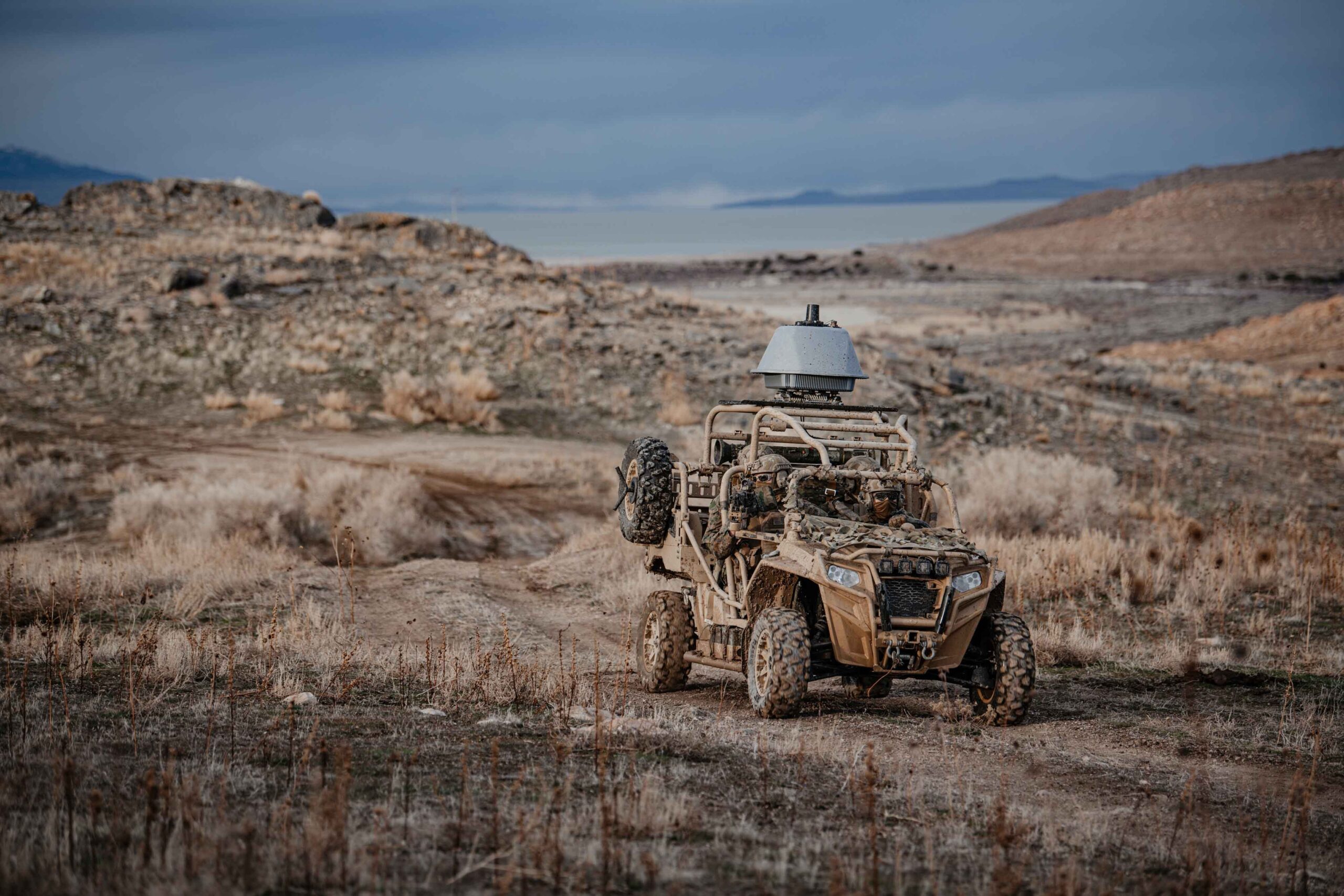
Photo: DroneSentry-X Mk2 courtesy of DroneShield.
Delivering Tactical Agility
Around the battlefield mobile forces are vulnerable as dozens of viral videos from Ukraine demonstrate. Whether mounted in a Stryker, an Infantry Squad Vehicle, maritime vessel, or large transport and refueling aircraft, warfighters on the move are high value drone targets.
DroneShield’s DroneSentry-X Mk2 offers mobile protection for a wide range of vehicles in a ruggedized, modular package that combines advanced AI-based RF detection and defeat capability in one compact, easy to install self-contained system providing full hemispheric protection.
Operators have full access to real-time alerts and active defeat settings via a user-friendly interface. Open architecture design and ready-to-integrate common and open interfaces allow the DroneSentry-X Mk2 to integrate into existing mission platforms and command and control systems.
DroneSentry-X provides immediate response capability whether speeding along a rutted path in a JLTV, at high speeds on the water or at the halt in an overwatch position. Human in the loop, autonomous and remote operational modes provide increased operational flexibility.
The platform is adaptable for rapid deployable fixed-site applications as well. Quick setup and disassembly options for expeditionary fixed site deployments are becoming a more desirable configuration as traditional permanent/semi-permanent fixed site towers are becoming more vulnerable and come with cumbersome logistics. As an expeditionary fixed-site option, the DroneSentry-X can be used as a standalone RF sensor and effector platform or easily incorporate a suite of additional sensors including long-range radar, acoustic sensors, and high-definition cameras offering a modular, layered solution.
Through existing deployments, DoD security personnel can visualize detection activity and coordinate the appropriate response via the DroneSentry-C2 Command and Control software, which provides a common operating picture for the C-UxS mission and is interoperable with existing government Command and Control and perimeter intrusion systems.
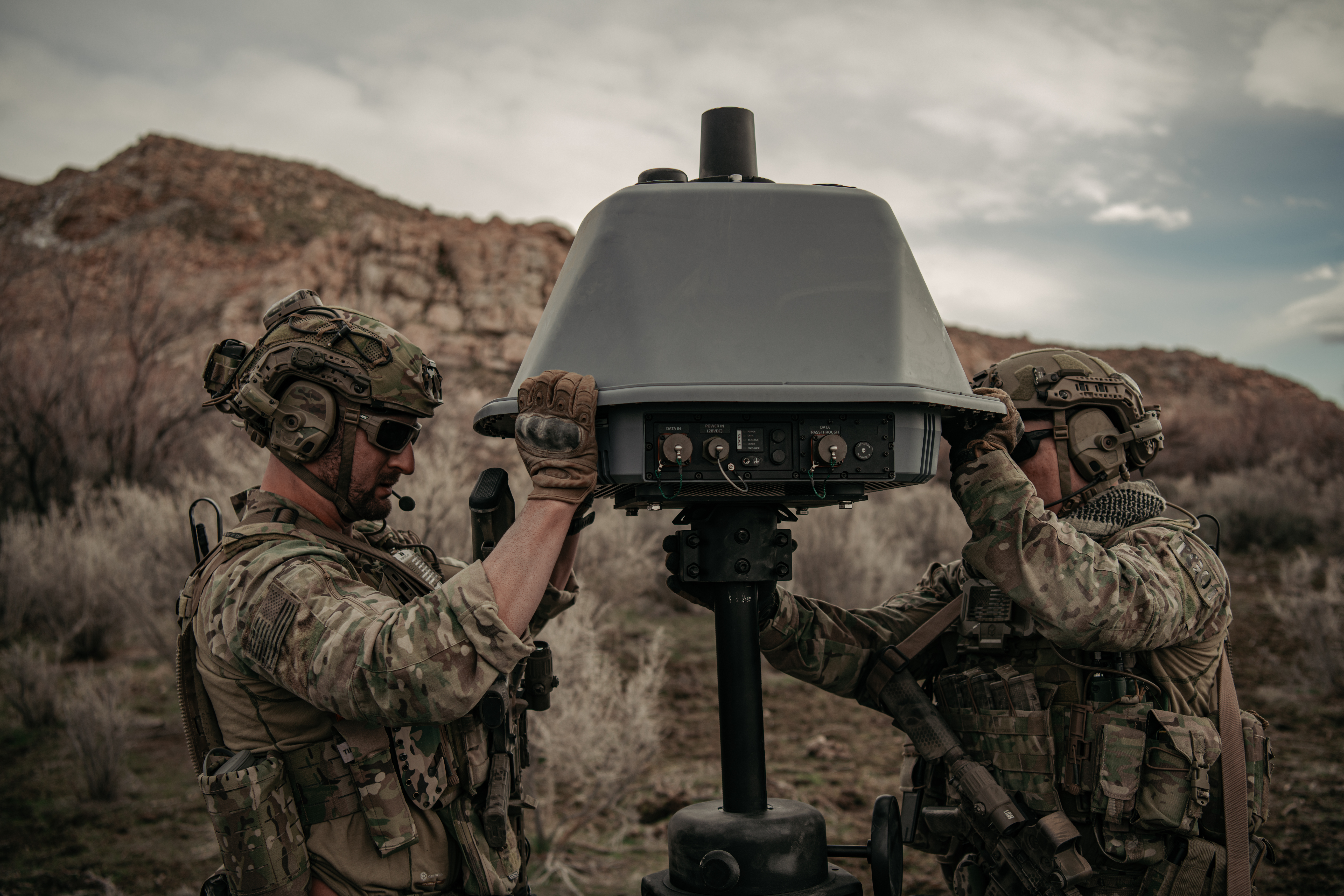
Photo: DroneSentry-X Mk2 Expeditionary Fixed-Site (EFS) courtesy of DroneShield.
While it expands its offerings and interoperability, DroneShield is also expanding its defense industry partnerships. It recently joined forces with high power microwave (HPM) innovator, Epirus, to plug the latter’s Leonidas HPM counter-electronics/UAS effector into its DroneSentry architecture. In late 2023, DroneShield integrated its fixed-site, non-kinetic DroneCannon Mk2 into Lockheed Martin Australia’s Agile Shield all-domain battle management system, proving its value in an Agile Shield field capability demonstration. The company also has a long-standing partnership with SAIC, providing the RF detection and mitigation layers for their partner’s comprehensive Counter-UAS system of systems solutions.
“The drone threat continues to evolve and proliferate across domains as witnessed with current conflicts,” DroneShield’s U.S. CEO, Matt McCrann stated. “It takes a whole of industry approach to solve for the emerging threats we face. That’s why we’re committed to supporting our Warfighters, allies, and partners as they look to meet the growing need for advanced counter-UxS solutions.”
The opportunity to make every soldier, sailor, Marine and airman counter-drone capable is real and DroneShield is poised to help DoD realize it.



